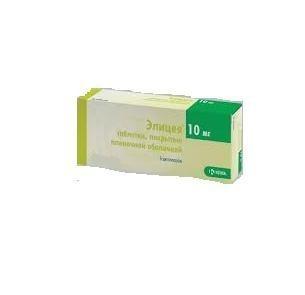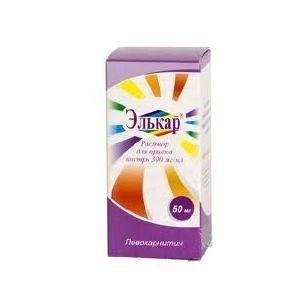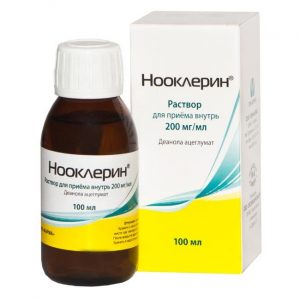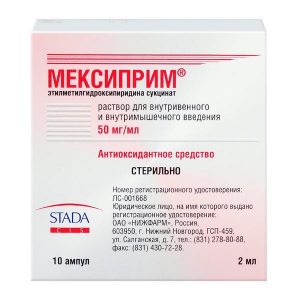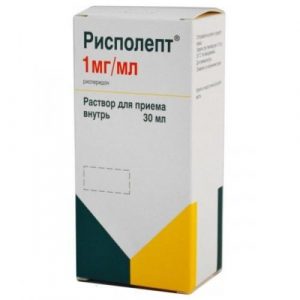Description
Packing
28 pcs.
Pharmacological action of
Elicea is an antidepressant, a selective serotonin reuptake inhibitor (SSRI), increases the concentration of the neurotransmitter in the synaptic cleft by inhibiting serotonin reuptake, enhances and prolongs the effect of serotonin on postsynaptic receptors. Escitalopram practically does not have or has a very weak affinity for a number of receptors, including serotonin: 5-HT1A, 5-HT2, dopamine: D1 and D2 1- and 2- and -Adrenoreceptors, histamine H1 receptors, m-cholinergic receptors, benzodiazepine and opioid receptors, which leads to the absence or weak severity of various anticholinergic, sedative, cardiovascular side effects. Escitalopram also does not bind or has a very low affinity for various ion channels, including Na +, K +, Cl-, Ca2 + channels.
Indications
Depression, panic disorder (including with agoraphobia).
Contraindications
Hypersensitivity, concomitant use of MAO inhibitors, age up to 15 years, pregnancy, lactation.
Use during pregnancy and lactation
The drug Elicea is not used during pregnancy (safety not established).
Due to the fact that escitalopram is secreted in breast milk, it is not recommended to use the drug during breastfeeding. If it is necessary to use the drug Elicea during lactation, breastfeeding should be discontinued.
Special instructions
Escitalopram should be prescribed only 2 weeks after the withdrawal of irreversible MAO inhibitors and 24 hours after the cessation of therapy with a reversible MAO inhibitor. Non-selective MAO inhibitors can be prescribed no earlier than 7 days after the withdrawal of escitalopram. In some patients with panic disorder, an increase in anxiety may occur at the beginning of escitalopram treatment, which usually disappears within the next 2 weeks of treatment. To reduce the likelihood of anxiety, it is recommended that low initial doses be used. The drug should be discontinued in case of the development of epileptic seizures or their increase in pharmacologically uncontrolled epilepsy. With the development of a manic state, escitalopram should be abolished. Escitalopram can increase the concentration of glucose in the blood in diabetes mellitus, which may require dose adjustment of hypoglycemic drugs. Clinical experience with the use of escitalopram indicates a possible increase in the risk of suicide attempts in the first weeks of therapy, and therefore it is very important to carefully monitor patients during this period. Hyponatremia associated with a decrease in ADH secretion rarely occurs with escitalopram and usually disappears when the drug is discontinued. With the development of serotonin syndrome, the drug should be immediately withdrawn and symptomatic treatment prescribed. During the treatment period, it is necessary to refrain from driving vehicles and engaging in potentially dangerous activities that require an increased concentration of attention and speed of psychomotor reactions.
Composition
1 tab. contains escitalopram 10 mg
Dosage and administration of
Elicea taken orally, regardless of food intake. Depressive episodes: 10-20 mg once a day. After the symptoms of depression disappear, it is necessary to continue therapy to consolidate the effect for 6 months. Panic disorders (including with agoraphobia): 5 mg / day for the first week, then 10-20 mg / day. The maximum daily dose is 20 mg. The duration of treatment is several months. Upon termination of treatment, the dose should be gradually reduced within 1-2 weeks in order to avoid the occurrence of withdrawal syndrome. In elderly patients (over 65 years), the recommended dose is 5 mg / day, the maximum daily dose is 10 mg. In mild to moderate renal failure, dose adjustment is not required. The recommended initial dose for decreased liver function during the first two weeks of treatment is 5 mg / day. Depending on the individual response of the patient, the dose may be increased to 10 mg / day. For patients with weak activity of the CYP2C19 isoenzyme, the recommended initial dose during the first two weeks of treatment is 5 mg / day. Depending on the individual response of the patient, the dose may be increased to 10 mg / day.
Side effects
1/100 to <1/10), infrequently (from> 1/1000 to <1/100), rarely (from> 1/10 000 to <1/1000), very rarely (from <1/10 000, including individual messages). From the cardiovascular system: infrequently – tachycardia rarely – bradycardia very rarely – orthostatic hypotension. From the hemopoietic system: very rarely – thrombocytopenia. From the nervous system: often – insomnia, drowsiness, dizziness, paresthesias, tremors, anxiety, anxiety, nightmares, infrequently – taste disturbances, sleep disturbances, fainting, gnashing of teeth, psychomotor agitation, akathisia, increased irritability, panic disorders, confusion rarely – serotonin syndrome (agitation, tremor, myoclonus, hyperthermia), aggressiveness, depersonalization, hallucinations, suicidal thoughts and behavior is very rare – dyskinesia, convulsive and manic disorders. On the part of the respiratory system: often – sinusitis, yawning infrequently – nosebleeds. From the digestive system: very often – nausea often – increased or decreased appetite, diarrhea, constipation, vomiting, dry oral mucosa infrequently – gastrointestinal bleeding (including rectal) very rarely – hepatitis. From the genitourinary system: often – ejaculation disorders, impotence, decreased libido, anorgasmia (in women) rarely – metrorrhagia, menorrhagia very rarely – urinary retention, priapism, galactorrhea. From the sensory organs: infrequently – mydriasis, visual disturbances, tinnitus. From the skin: often – excessive sweating, alopecia is very rare – ecchymosis. From the musculoskeletal system: often – arthralgia, myalgia. From the endocrine system: very rarely – inadequate secretion of antidiuretic hormone, galactorrhea. Allergic reactions: often – urticaria, skin rash, itchy skin rarely – anaphylactic reactions very rare – angioedema (Quincke’s edema). Other: often – weakness, fever rarely – swelling. On the part of laboratory indicators: often – weight gain is infrequent – weight loss is very rare – hyponatremia, a change in laboratory parameters of liver function. With a sharp withdrawal of the drug, withdrawal syndrome may develop. Drug Interactions When taken with MAO inhibitors, the risk of developing serotonin syndrome and serious adverse reactions increases. Joint use with serotonergic drugs (including tramadol, sumatriptan, and other triptans) can lead to the development of serotonin syndrome. Concomitant use with drugs that lower the threshold of convulsive readiness increases the risk of seizures. Enhances the effect of tryptophan and Li + drugs. Increases the toxicity of St. John’s wort. Enhances the effect of drugs, affecting blood coagulation (requires monitoring of blood coagulation). Drugs metabolized with the participation of the CYP2C19 system (including omeprazole), as well as being strong inhibitors of CYP A4 and CYP2D6 (including flecainide, propafenone, metoprolol, desipramine, clomipramine, nortriptyline, risperidone, thioridazole, haloperide) escitalopram concentration. Increases the plasma concentration of desipramine and metoprolol 2 times. Overdose Symptoms: dizziness, tremor, agitation, drowsiness, serotonin syndrome, convulsions, depression of consciousness of varying severity (especially in combination with alcohol and / or other agents, depressant function, CNS) ECG changes (change in ST segment, T-tooth, expansion of QRS complex, increase in QT interval), arrhythmias, respiratory depression, metabolic acidosis, rhabdomyolysis, hypokalemia, hyponatremia. Treatment: carry out symptomatic and supportive therapy: gastric lavage, activated carbon intake, airway patency, adequate oxygenation, control of cardiovascular and respiratory system functions. There is no specific antidote. Storage conditions The product should be stored out of the reach of children at a temperature not exceeding 30 ° C, in the original package. Shelf life 2 years. Deystvuyushtee substance stsitalopram Prescription conditions pharmacy Prescription Dosage form tablets Possible product names ELICE 0.01 N28 TABLE P / O ELICE 0.01 N28 TABLE P / FILM / SHELL Elice 10mg Tab. p / pl / rev X28 Elice tab p / o 10mg x 28 ELICE TAB. P.P.O. 10MG No.28 KRKA d.d. Novo mesto AO, Slovenia
